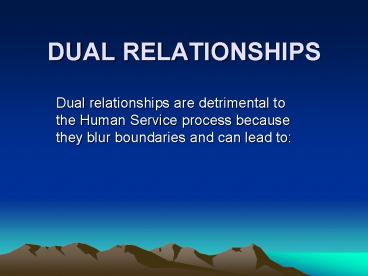DUAL RELATIONSHIPS - PowerPoint PPT Presentation
Title:
DUAL RELATIONSHIPS
Description:
DUAL RELATIONSHIPS Dual relationships are detrimental to the Human Service process because they blur boundaries and can lead to: Exploitation: Clients often perceive ... – PowerPoint PPT presentation
Number of Views:77
Avg rating:3.0/5.0
Title: DUAL RELATIONSHIPS
1
DUAL RELATIONSHIPS
- Dual relationships are detrimental to the Human
Service process because they blur boundaries and
can lead to
2
- Exploitation Clients often perceive Human
Service professionals possessing an exaggerated
sense of power and wisdom that, when applied in
non-Human Service relationships, can be
accidentally or intentionally manipulative or
exploitative. - Loss of Objectivity The non-Human Service role
often distorts the Human Service relationship
(Human Service professional-to-client as well as
client-to-Human Service professional) resulting
in a loss of needed clinical objectivity. - Potential for Misunderstanding Clients and
Human Service professionals when engaged in
multiple relationships have difficulty containing
the Human Service experience to the designated
Human Service time and place. This invites
misunderstanding and hurt feelings. - Breach of Confidentiality When there is role
confusion, it can be difficult for the Human
Service professional and the client to remember
what information was gained in the context of a
Human Service relationship and what in the
non-Human Service relationship. A real or
perceived breach of confidence often occurs.
3
- 2. Dual relationship issues affect virtually all
Human Service professionals in all settings.
Very few professional Human Service professionals
remain untouched by potential dual role conflicts
and dilemmas. - 3. Nearly all ethical codes of conduct caution
against dual relationships. - 4. Occasionally a dual relationship is
unavoidable. However, most dual relationships
can and should be avoided.
4
- 5. Dual relationships are the "royal road" to
liability problems. Many, many ethical
licensing complaint and liability issues can be
traced back to poorly conceived and/or poorly
managed dual relationships. - 6. Most dual relationships start out
well-intended, seeming clear and simple. Over
time they become increasingly muddy and
problematic. - 7. Sexual/Romantic relationships with current
clients, or terminating Human Service in order to
initiate a sexual relationship, is unethical and
illegal in many states. Consequences for such
behavior can include ethical sanction/expulsion,
revocation of license, civil suit and even
criminal prosecution.
5
- 8. In determining whether to proceed with a dual
relationship, consider whether the potential
benefit of the dual relationship outweighs the
potential for harm. - 9. Whenever we are operating in more than one
role and when there is potential for negative
consequences, the Standard of Practice will place
the responsibility for developing safeguards and
measures to reduce the potential for harm
squarely on the shoulders of the professional
Human Service professional. - 10. Dual role relationships, if they must exist,
challenge practitioners to closely monitor
themselves and to examine their motivations for
engaging in the dual role.
6
- 11. When considering becoming involved in a dual
relationship, it would be wise to seek
consultation from trusted colleagues or a
supervisor. - 12. When presented with a dual relationship
decision determine if the dual relationship is
avoidable or unavoidable assess the potential
benefits and risks of initiating a secondary
relationship and discuss the issue with a trusted
colleague for their objective perception. If the
dual relationship is avoidable or the risks
associated with the dual relationship outweigh
the benefits, decline the secondary non-Human
Service relationship or refer the person
requesting the Human Service worker (friend or
social or work acquaintance) to another Human
Service professional. If the secondary
relationship (Human Service or non-Human Service
worker) is initiated, fully explain to the client
the potential difficulties and risks associated
with dual relationships, carefully define the
boundaries of both relationships, record the
substance of this discussion in the clinical
record, secure a written consent for treatment
that acknowledges the dual relationship, and
obtain on-going supervision.
7
TYPES OF DUAL RELATIONSHIPS
Primary dual relationship
YOUR FAMILY MEMBER YOUR ROMANTIC/SEXUAL PARTNER YOUR FRIEND Your business/professional
8
Secondary dual relationship
YOUR FAMILY Member's YOUR ROMANTIC/SEXUAL Partner's YOUR Friend's Your business/professionals
Friend Lover Business/professional Friend Other lover Family Business/professional Friend lover Family Other friend Business/profesional Friend lover Family Other friend Business/profesional
9
Tertiary dual relationship
YOUR FAMILY Member's YOUR ROMANTIC/SEXUAL Partner's YOUR Friend's co-workers Your co-workers Family
Friend Lover Business/professional Friend Other lover Family Business/professional Friend lover Family Friend lover Other friend Co-worker
10
- 'Business Other Professional Co-worker,
teacher, student, intern, supervises, contractor,
accountant, business partner, doctor, etc.































